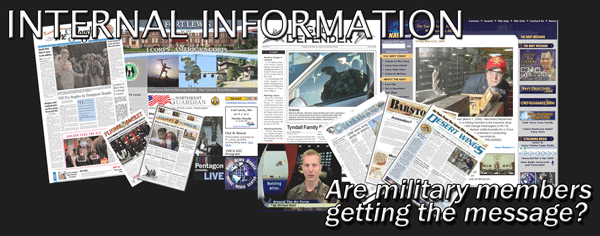The purpose of this study was to examine the uses of internal communication forms among active duty military personnel. The experiment also collected data on attention and use of non-military media. Finally, the study examined active duty military personnel’s attitude about base newspapers.
Correlations and Frequencies
Hypothesis 1 predicted that gratifications of online news would be positively correlated to base newspaper use. To examine H1 a correlation matrix was computed. This hypothesis was supported. All correlations were positive in nature and statistically significant at p<.01 (refer to table 1).
To analyze hypotheses 2, 3, 4, and research question 1, and 2, uses and gratifications mean scores were examined across five dimensions (entertainment, decisional utility, interpersonal utility, general information seeking, and parasocial interaction), for each of four military communication forms (base newspapers, online newspapers, internet websites, and commander’s access channels).
Hypothesis 2a predicted base newspapers and online base newspapers would score high on the entertainment gratification. Hypothesis 2a was not supported. The overall means were moderate for entertainment gratification for base newspapers (M=3.10), and low for the entertainment gratification for online base newspapers (M=2.43).
Hypothesis 2b predicted that internal websites and the commander’s access channel would not satisfy an entertainment gratification. Hypothesis 2b was supported. People did not use the internal base website (M=2.17) or the commander’s access channel (M=1.53) to satisfy an entertainment gratification.
Hypothesis 3a predicted online base newspapers would have high decisional utility. Hypothesis 3a was not supported. Online base newspapers scored moderately in terms of decisional utility (M=2.84).
Hypothesis 3b predicted base newspapers, the commander’s access channel, and internal base websites would have limited decisional utility.
Hypothesis 3b was partially supported. The commander’s access channel scored low in decisional utility (M=1.65), whereas base newspapers (M=3.21) and internal base website (M=2.66) rated moderately in decisional utility.
Hypothesis 4a predicted that the printed base newspaper, online base newspaper, and the commander’s access channel would carry moderate interpersonal utility gratifications. Hypothesis 4a was partially supported. The printed base newspaper (M=3.27) and the online base newspaper (M=2.81) both manifested a moderate of interpersonal utility gratification.
However, the commander’s access channel (M=1.68) scored low in interpersonal utility gratification. Hypothesis 4b predicted the internal base website would have little interpersonal utility gratification. The results indicated that internal base websites (M=2.55) rated moderate in interpersonal utility gratification.
Research Question 1 probed which of the five gratification dimensions the commander’s access channel and internal base website satisfy. The results revealed that the commander’s access channel provided limited gratification of any kind. Gratifications scores were: to gain information (M=1.87), to satisfy interpersonal utility (M=1.68), decisional utility (M=1.65), parasocial interaction (M=1.64), and entertainment (M=1.53).
By contrast the internal base website satisfied some gratifications more than others. Gratification scores were: gain information (M=3.06), decisional utility (M=2.66), interpersonal utility (M=2.55), parasocial interaction (M=2.44), and entertainment (M=2.17).
Research Question 2 examined how military personnel use internal communication forms to meet the dimension of parasocial interaction.
Internal communication forms used to meet this dimension are ranked as follows: base newspaper (M=3.13), online newspaper (M=2.51), internal website (M=2.25), commander’s access channel (M=1.64).
Research Question 3 sought to explain what communication forms active duty military personnel are utilizing. Specifically, Research Question 3 examined how uses compare across military and civilian media. To examine this question, descriptive statistics were used to examine the pattern of means. Civilian and internal communication media forms rank as follows: television news use (M=7.48; s.d.=1.59); internal base website (M=7.13; s.d.=2.81); local television news (M=6.85; s.d.=2.46); base newspaper (M=5.88; s.d.=2.59); online civilian newspaper (M=5.47; s.d.=2.63); print military magazine (M=5.29; s.d.=2.55); online military magazine (M=5.23; s.d.=2.79); primetime television (M=5.14; s.d.=2.96); television talk shows (M=4.64; s.d.=3.12); civilian web pages (M=4.52; s.d.=3.13); online base newspaper (M=4.36; s.d.=3.06); television entertainment (M=4.25; s.d.=2.89); television magazine shows (M=4.14; s.d.=2.86); radio news (M=3.88; s.d.=3.07); radio talk shows (M=3.74; s.d.=2.76); print civilian magazines (M=2.97; s.d.=2.47). See Table 2.
Regression Analyses
Research Question 4 examined what demographics or dimensions of uses and gratifications predict attitude toward the base newspaper. A hierarchical regression analysis was conducted to prove this question.
The results are summarized in Table 3. The first predictor block consisted of demographics (age, gender, and rank). The second block of variables included the five dimensions of uses and gratifications (entertainment, decisional utility, interpersonal utility, general information seeking, and parasocial interaction). Age of personnel (b=-.20, p<.05) and the uses and gratifications dimension of decisional utility (b=-.40, p<.10) were the only significant predictors of attitude about the base newspaper. The results indicate that older active duty personnel have more negative attitudes about the base paper, and that military people do not use the base paper for decisional utility.
TABLE 1 TABLE 2 TABLE 3
BACK TO TOP
